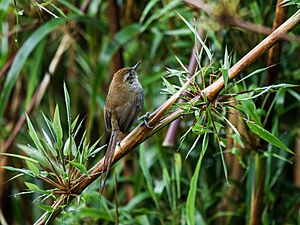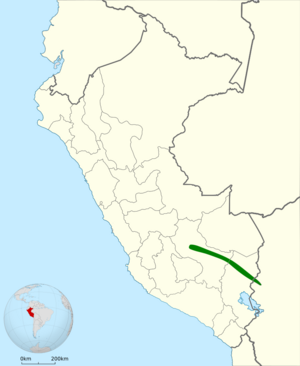Puna thistletail facts for kids
Quick facts for kids Puna thistletail |
|
|---|---|
 |
|
| Conservation status | |
| Scientific classification | |
| Genus: |
Asthenes
|
| Species: |
helleri
|
 |
|
| Synonyms | |
|
Schizoeaca helleri |
|
The puna thistletail (Asthenes helleri) is a small bird that belongs to the ovenbird family. These birds are found in the high mountains of Peru and Bolivia.
Contents
Understanding the Puna Thistletail
Scientists group living things into categories. The puna thistletail is part of a group called Asthenes. It used to be in a different group, Schizoeaca. However, new information from DNA showed that it fits better with the Asthenes birds.
Some people thought the puna thistletail was the same species as other similar birds. But genetic tests proved they are all different species. The puna thistletail is currently considered a single species without different types or subspecies.
What Does the Puna Thistletail Look Like?
The puna thistletail is about 17 to 18.5 centimeters (6.7 to 7.3 inches) long. It weighs between 13 and 17 grams (0.46 to 0.60 ounces). Both male and female birds look the same.
Their face is brownish-gray with a lighter gray stripe above their eye. The top of their head is dark reddish-brown. Their back, rump, and wings are also dark reddish-brown. Their tail is a brighter reddish-brown. It is long and split deeply at the end, with very few feathery parts on the tips.
The puna thistletail has a white chin. Some birds have a small reddish spot in the middle of their chin. Their throat has a blackish patch with light gray spots. Their belly is mostly gray. Their sides and the feathers under their tail have a brownish tint. Their eyes can be brownish-gray, gray, or light tan. Their beak is dark gray to black on the top part and gray to whitish with a dark tip on the bottom part. Their legs and feet are gray to bluish-gray.
Where Do Puna Thistletails Live?
The puna thistletail lives in the Andes Mountains. You can find them from the Cuzco region in Peru down to the La Paz region in Bolivia.
They live in a special type of forest called "elfin forest." This forest is found near the tree line, where trees start to become scarce. They especially like areas with lots of dense Chusquea bamboo plants. These birds live at high elevations, usually between 2,700 and 3,700 meters (8,900 and 12,100 feet) above sea level.
Puna Thistletail Behavior
How Do Puna Thistletails Move?
Puna thistletails stay in the same area all year round. They do not migrate to other places.
What Do Puna Thistletails Eat?
These birds mainly eat arthropods, which are small creatures like insects and spiders. They usually look for food alone or in pairs. They mostly search for food in the lower parts of the forest. Sometimes, they will look higher up in the trees. They find their food by picking it off leaves, small branches, and moss.
Puna Thistletail Life Cycle
Scientists are still learning about when puna thistletails breed. We know they breed at least in October. It is believed that they stay with one partner for life.
Their nest is shaped like a dome with an opening on the side. They build it using moss and a few small twigs. They usually place their nest on a clump of grass. The nests found so far have had two eggs. Not much else is known about how they raise their young.
Puna Thistletail Sounds
The puna thistletail is a very vocal bird. Both male and female birds sing. Their song is a short, fast, high-pitched series of sputtering notes. It sounds like "pee-peep-p-p-p-t-t-tii." The song gets faster and louder before it fades away at the end. Their call is a sharp note, like "pyeek," "preek," "peent," or "feet."
Puna Thistletail Conservation Status
The IUCN (International Union for Conservation of Nature) checks on how safe different species are. The puna thistletail was first listed as "Least Concern." Then, in 2012, it was changed to "Vulnerable." In 2021, it was changed back to "Least Concern."
This bird lives in a large but narrow area. We do not know exactly how many puna thistletails there are. However, their population is thought to be stable. The main danger to this species is the loss of its home. This happens when forests are cut down. The puna thistletail may also be affected by animals grazing and fires in its mountain habitat. Luckily, this bird lives in at least two protected areas in Peru.


